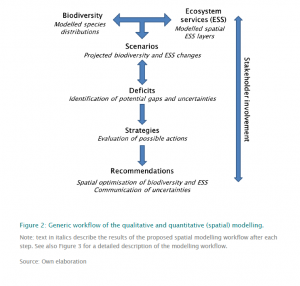Ecosystem-based management recognizes the importance of the interactions within an ecosystem, including humans, rather than considering single issues, species or ecosystem services in isolation. Understanding these interdependencies helps distinguish management options, priorities for conservation, and the impact of various scenarios on biodiversity.
The aim of this report, Modelling approaches for the assessment of projected impacts of drivers of change on aquatic biodiversity, ecosystem functions and aquatic ecosystem service delivery, is to provide guidance on how to combine qualitative and quantitative modelling techniques to jointly assess the interactions between biodiversity, ecosystem functions and ecosystem services.
The report presents the possibility of using a Linkage Framework for qualitative analysis and results, or a Spatially-explicit Modelling Framework that uses statistical and predictive models across space and time. The qualitative linkage framework is useful to assess the overall relationships and to help identify essential links among biodiversity, ecosystem function and ecosystem services. The spatially explicit modelling framework aims to analyse and to prioritise biodiversity, ecosystem function and ecosystem services across the entire case study area using robust data on specific ecosystem function or ecosystem services. The spatially explicit framework then yields a spatial representation of important biodiversity and management zones and how much and which amount of costs these may represent in a feasible solution, given the uncertainties.
The authors find that using modelling to map out management decisions helps communicate options to stakeholders and allows for the consideration of multiple approaches with different outcomes. It therefore increases the knowledge base on which decisions are made, and reduces the risk of having to take retroactive measures resulting from trial and error type management.
The Full Report and Executive Summary are available online.


